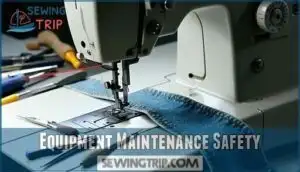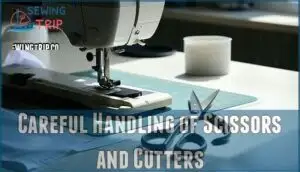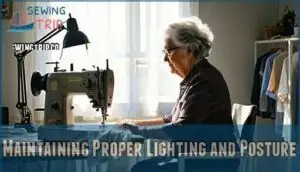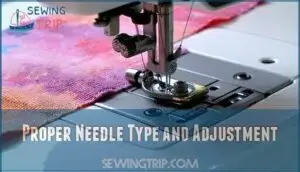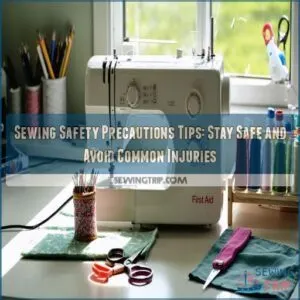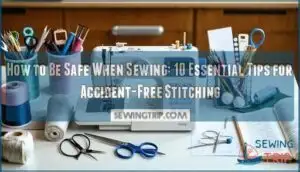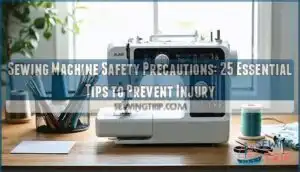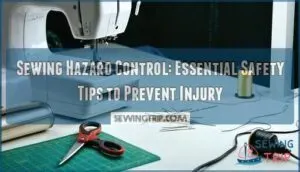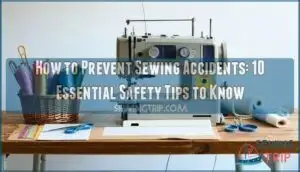This site is supported by our readers. We may earn a commission, at no cost to you, if you purchase through links.
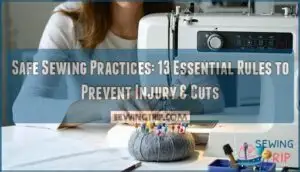
You’ll want to unplug your machine when threading or changing needles, keep sharp tools properly stored, and maintain good posture to avoid strain.
Don’t rush through projects – that’s when accidents happen.
Use the right needle for your fabric, secure loose hair and clothing, and keep your fingers away from the needle area.
A magnetic pin holder beats scattered pins on the floor every time.
Good lighting prevents eye strain and helps you spot potential hazards before they become problems.
These foundational safety habits create the groundwork for more advanced protective techniques.
Table Of Contents
Key Takeaways
- Unplug your sewing machine before threading, changing needles, or making any adjustments to prevent electrical shocks and accidental starts that could cause serious injuries.
- Keep your fingers at least one inch away from the needle area and never sew over pins, as broken needles can damage your machine and send sharp fragments flying.
- Store all sharp tools properly in magnetic holders, protective sheaths, or designated containers to prevent cuts from loose needles, scissors, and rotary cutters scattered around your workspace.
- Set up proper lighting and take regular breaks every 30-45 minutes to prevent eye strain and maintain good posture, which reduces your risk of repetitive strain injuries.
General Safety Practices
Sewing should be enjoyable, not dangerous—but sharp tools and electrical equipment can turn your crafting session into a trip to the emergency room if you’re not careful.
Following basic safety practices protects you from cuts, electrical shocks, and repetitive strain injuries that can sideline your sewing projects for weeks.
Handling Sharp Tools
Sharp tools demand respect in your sewing space. Store needles, scissors, and rotary cutters properly to prevent accidents that’ll make you wish you’d been more careful.
- Keep needles in magnetic holders or pincushions, never loose in drawers
- Store scissors in protective sheaths or designated tool organizers
- Always retract rotary cutter blades when not actively cutting
- Use wrist pincushions for easy access during sewing projects
- Maintain sharp, rust-free tools to prevent slipping and accidents
To improve accuracy, consider using essential measuring tools for every project to ensure a successful outcome.
Preventing Electrical Shocks
While handling sharp tools requires care, electrical hazards pose equally serious risks.
Always unplug your sewing machine before maintenance or adjustments to prevent electrical shock.
Inspect cords regularly for damage, and replace frayed ones immediately.
Use surge protectors and avoid outlet overload.
To further guarantee safety, always consult your sewing machine manual for specific guidelines.
Keep machines away from wet conditions, and consider voltage transformers for power stability.
Ground faults can occur unexpectedly, so maintain proper electrical cord safety practices.
Maintaining Ergonomic Workspace
Your body deserves better than hunching over a cramped sewing table like you’re solving a puzzle.
Set up ergonomic seating with proper lumbar support and adjust your chair height so your feet rest flat on the floor.
Position your sewing machine at elbow height to maintain good sewing posture.
Organized layout with adequate lighting solutions prevents eye strain and back tension while supporting injury prevention through workspace organization.
Always remember to address hot iron safety by placing them on heat-resistant surfaces to ensure injury prevention.
Avoiding Eye Strain and Fatigue
Your eyes deserve the same care as your fingertips when sewing.
Your sewing workspace deserves the same attention as your stitching technique.
Take breaks every 30-45 minutes to prevent eye strain and maintain proper lighting with LED lamps or natural sunlight.
Good sewing posture reduces neck tension while screen breaks and simple eye exercises keep your vision sharp.
Ergonomic breaks aren’t just luxury—they’re essential for your sewing wellbeing and long-term comfort, providing a clear example of why proper lighting is crucial.
Equipment Maintenance Safety
Your sewing machine’s health depends on regular maintenance to keep you safe and your projects running smoothly.
Proper equipment care prevents electrical hazards, mechanical failures, and costly repairs that could sideline your creative work, and it is essential for proper equipment care.
Regular Machine Inspection
You’ll want to inspect your machine regularly for wear and tear, checking that everything runs smoothly.
Listen to the motor sound during operation – unusual noises often signal maintenance needs.
Test pedal functionality and verify your machine has a secure setup on a stable surface.
Don’t forget voltage checks before use to prevent motor damage and maintain proper sewing machine safety.
Proper Cord and Plug Management
Before plugging in your sewing machine, examine electrical cords for frays, cracks, or damage that could cause shocks.
Replace worn cords immediately and avoid outlet overload by using one machine per power strip. Heavy-duty extension cords prevent voltage drops, while surge protectors shield against electrical hazards.
Never force damaged plugs into outlets. Inspecting cords is a part of a weekly maintenance task to guarantee safety. Using heavy-duty extension cords and surge protectors can help prevent accidents.
Surge Protector Usage
Your computerized sewing machine needs surge protectors to shield against voltage fluctuations that can destroy expensive electronics.
Choose a power strip with at least a 2,000 joule rating and UL certification for electrical safety.
Replace surge protectors every two to five years since their protector lifespan degrades with each surge absorbed.
Consider specialized sewing options for enhanced protection.
Correct usage means avoiding daisy-chaining and monitoring replacement frequency through indicator lights that signal when electrical hazards increase.
Machine Lubrication and Cleaning
Everyone knows that proper machine maintenance keeps your sewing equipment running smoothly and safely.
Regular cleaning and lubrication prevent costly breakdowns and extend your machine’s life substantially.
- Oil your sewing machine every 6 months using manufacturer-recommended lubricant types for ideal frequency
- Remove lint buildup from ventilation openings with cleaning tools to prevent overheating and fire hazards
- Clear thread scraps from feed dogs and bobbin areas to avoid sewing machine problems
- Schedule professional servicing every 1-2 years to catch potential sewing machine safety issues early
Handling Sharp Objects
Sharp objects are the backbone of sewing, but they can turn dangerous faster than you can say "ouch."
You’ll want to master safe handling techniques to keep your fingers intact and your projects flowing smoothly.
Safe Storage of Needles and Pins
Multiple needle and pin storage options exist that’ll keep your sharp tools organized and safe.
The key is finding what works best for your workspace while keeping everyone protected. Store needles in secure containers and pins in designated holders to prevent injuries and accidental swallowing hazards.
| Storage Method | Best For |
|---|---|
| Magnetic Holders | Quick access during active sewing |
| Wrist Pincushions | Convenient pin management while working |
| Sealed Containers | Child safety and long-term storage |
| Tomato Pincushions | Traditional workspace organization |
| Magnetic Strips | Wall-mounted needle organization |
Careful Handling of Scissors and Cutters
Sharp scissors and rotary cutters demand respect—they’re not toys. Always cut away from your body, never toward it, and retract blades immediately after use.
Keep cutting tools sharp since dull blades require more pressure and can slip. A key element of sewing scissors care is regular cleaning to remove fabric residue.
- Store scissors in protective sheaths and rotary cutters with safety locks engaged
- Replace dull blades promptly—sharp tools are actually safer than dull ones
- Use proper cutting mats to protect blade edges and work surfaces
Using Magnetic Pin Holders
Magnetic pin holders transform your sewing workspace into a safer, more efficient environment.
These handy tools use strong magnets to securely hold steel and nickel pins, preventing dangerous spills and reducing injury risks.
You’ll find various holder types that offer ergonomic advantages for different sewing projects.
A great place to find these handy tools is online.
| Holder Type | Magnetic Benefits | Pin Security |
|---|---|---|
| Wrist Band | Hands-free convenience | Secure attachment during movement |
| Tabletop Dish | Strong magnetic field | Holds multiple pins safely |
| Magnetic Wand | Floor cleanup capability | Collects dropped pins instantly |
| Clip-On Style | Portable workspace solution | Prevents pin scattering |
| Bowl Design | Large capacity storage | Keeps pins organized and accessible |
Remember that magnetic pin holders work best with steel pins but won’t attract brass ones.
Keep these tools away from pacemakers and handle them gently to avoid pinching injuries from strong magnetic attraction.
Avoiding Accidental Cuts and Injuries
Beyond organizing pins with magnetic holders, protecting yourself from cuts requires constant awareness of blade safety and proper needle handling. Sharp tools demand your respect – one moment of carelessness can lead to puncture wounds requiring first aid or worse.
- Keep cutting tools pointed away from your body – rotary cutters and scissors should always cut away from you to prevent accidental slashes.
- Remove pins as you sew – leaving pins in fabric creates sewing hazards when they break or cause needle damage.
- Store sharp tools immediately after use – proper tool organization prevents sewing accidents when you reach for supplies.
- Maintain focus during needle handling – injury prevention starts with staying alert and avoiding distractions while working with sharp implements.
Sewing Machine Operation
Your sewing machine can be your best friend or your worst enemy, depending on how you treat it.
Proper machine operation isn’t just about getting clean stitches—it’s about keeping your fingers intact and your projects accident-free.
Maintaining Proper Lighting and Posture
Good posture and proper lighting protect your eyes and back during long sewing sessions.
Position adjustable lamps to eliminate shadows on your work area, preventing eye strain that leads to headaches.
Choose ergonomic seating that supports your spine and take posture breaks every thirty minutes to avoid back tension.
LED lighting types work best for vision health, while ergonomic furniture keeps you comfortable and focused.
Avoiding Rushing and Distractions
When you rush through sewing projects, you’re setting yourself up for accidents and costly mistakes. Take your time, especially as a beginner, since hasty movements can lead to severe injuries. Prioritize safety over speed to maintain sewing vigilance and create a calm environment for mindful sewing.
- Focus your attention entirely on the needle and fabric movement
- Keep your workspace free from distractions like phones or loud music
- Practice sewing precautions by lifting your foot off the pedal when interrupted
- Maintain focused attention to avoid beginner mistakes that damage machines
- Create a calm environment where you can concentrate on safe sewing practices
To ensure a successful sewing experience, remember that mindful sewing requires patience and attention to detail. By following these guidelines, you can minimize the risk of accidents and produce high-quality sewing projects.
Regularly Checking and Tightening Screws
Since loose screws create vibrations that compromise machine stability, you’ll want to check and tighten them regularly using appropriate tools.
Different screw types require specific tightening frequencies—typically monthly for heavy users.
This simple sewing machine maintenance step prevents costly repairs and helps keep your sewing safety precautions remain effective throughout extended use.
Regular cleaning helps prevent skipped stitches, which is a crucial aspect of maintaining your machine to ensure effective performance.
Proper Needle Type and Adjustment
Your needle-and-thread partnership needs perfect harmony to prevent sewing safety disasters.
Choose the right needle size using a fabric compatibility guide—size 70/10 for delicate fabrics, 90/14 for denim—and match thread weight accordingly.
Proper needle adjustment with the flat side facing rear prevents breakage, while regular replacement after 6-8 hours of sewing keeps your machine humming safely.
Workspace Setup and Ergonomics
Your workspace setup directly impacts your safety and comfort while sewing.
You’ll want to create separate zones for cutting, sewing, and ironing while keeping electrical cords tucked away and maintaining proper lighting to prevent accidents, ensuring a comfortable and comfort environment is not the focus but rather a safe one.
Establishing a No-Fingers Zone
Beyond proper machine operation, you’ll want to create a visual no-fingers zone around your needle area for enhanced Machine Awareness and injury prevention.
This simple step dramatically improves Needle Safety, especially for beginners learning Speed Control.
Here’s how to establish your safety zone:
- Apply red painter’s tape around the throat plate to mark danger areas
- Install finger guards on your machine for physical Beginner Safety protection
- Position hands on fabric sides – never directly in needle’s path
- Use tweezers or seam rippers instead of fingers for fabric adjustments
- Stop machine completely when repositioning work or making changes
These sewing safety measures create automatic habits that prevent accidents before they happen.
Routing Electrical Cords Safely
Smart cord placement prevents tripping hazards that could send you tumbling into sharp tools.
Route electrical cords along walls using cable management systems, keeping them away from walkways. Extension cords should lie flat against baseboards, never stretched across open spaces.
Secure routing with cord covers protects against short circuits while maintaining electrical safety around your sewing machine, which is crucial for preventing accidents and ensuring a safe working environment with proper cord management.
Separating Tables for Sewing and Cutting
Creating dedicated spaces for different tasks prevents accidents and streamlines your workflow. You’ll reduce injury risk by keeping sharp cutting tools separate from your sewing area, where they could cause accidents if knocked over.
Here’s how to optimize your workspace:
- Cutting Mat Station – Use a large, stable table for rotary cutters and fabric cutting
- Sewing Machine Area – Keep this space clear of loose fabric scraps and cutting tools
- Project Organization – Store current projects near their respective work zones
- Ergonomic Benefits – Position each table at proper height for standing or sitting comfort
This Space Optimization approach enhances Workflow Efficiency while following essential sewing safety guidelines for your sewing room safety setup.
Maintaining a Well-Lit and Organized Workspace
Good workspace layout transforms your sewing room safety from chaotic to controlled.
Proper lighting options prevent eye strain while ergonomic seating supports your posture during long projects.
Smart cord management keeps electrical hazards at bay, and storage solutions organize sharp tools safely.
Following these sewing safety guidelines creates a workspace that protects you from injury.
Ideal conditions require specialized sewing illumination for a controlled environment.
Frequently Asked Questions (FAQs)
Do you know sewing safety rules?
Imagine this scenario: a seamstress accidentally sews through her finger because she ignored the golden rule of keeping fingers away from needles.
You’ll want to unplug machines before adjustments, store sharp tools safely, and maintain proper lighting to prevent accidents.
What are sewing machine safety tips?
Always unplug your machine before threading or adjusting.
Keep fingers at least one inch from the needle.
Never sew over pins.
Maintain good lighting and take breaks to prevent eye strain and fatigue.
What is the most important sewing machine safety rule?
Never sew over pins or needles—they’ll break, potentially damaging your machine and sending sharp fragments flying. Always remove pins before they reach the needle area for safe operation.
How to make a sewing machine safe and accident-free?
Like threading a needle in a storm, keeping your sewing machine safe requires steady hands and smart habits.
Always unplug before adjustments, keep fingers one inch from needles, maintain proper lighting, and never sew over pins to prevent accidents, which is a smart habit.
What is sewing safety?
Sewing safety means protecting yourself from injuries while crafting. You’ll handle sharp tools like needles and scissors carefully, maintain proper posture, and keep your workspace organized to prevent accidents.
What are sewing safety precautions?
Keep your hands away from the needle, unplug machines before adjustments, store sharp tools safely, maintain good lighting, take regular breaks, and organize your workspace properly.
How to be safe when using a sewing machine?
Ironically, machines designed to make life easier can quickly turn dangerous if you’re not careful.
Always unplug before adjustments, keep fingers away from needles, and maintain proper posture to prevent accidents.
What are the safety tools for sewing?
Essential safety tools include sharp scissors, quality needles, pincushions, thimbles, seam rippers, and needle guards. You’ll also need proper lighting, ergonomic seating, and secure storage containers to prevent injuries.
What are the safety precautions while sewing PPT?
Like threading a needle in a storm, presentation safety requires steady hands and clear vision.
Always unplug machines before adjustments, keep fingers away from needles, secure sharp tools, maintain good lighting, and take regular breaks to prevent fatigue.
What are the safe operating procedures for sewing machines?
Always unplug your sewing machine before making adjustments or threading.
Keep fingers at least one inch from the needle, turn off when not in use, and avoid sewing over pins to prevent damage.
Conclusion
Building a fortress of safety around your sewing station protects both your projects and your precious fingers from unexpected mishaps.
These safe sewing practices aren’t just suggestions—they’re your shield against preventable injuries that could sideline your creativity.
When you consistently follow proper equipment handling, maintain organized workspaces, and respect sharp tools, you’ll transform potential hazards into manageable elements of your craft.
Remember, the best seamstress isn’t the fastest one, but the one who finishes every project with all ten fingers intact, emphasizing the importance of proper equipment handling and being a safe seamstress.
- https://ehs.ucr.edu/sites/default/files/2019-07/Shop_Safety_Safe_Work_Procedure_SEWING_MACHINE.pdf
- https://ucanr.edu/sites/default/files/2011-06/102517.pdf
- https://library.mcmaster.ca/sites/default/files/uploaded_files/sewing_machine_safety_checklist.pdf
- https://pmc.ncbi.nlm.nih.gov/articles/PMC7502893/
- http://yesterdaysthimble.com/articles/sewing-room-safety-14-tips/

